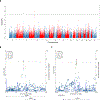Genome-wide association identifies the first risk loci for psychosis in Alzheimer disease
- PMID: 34112972
- PMCID: PMC8660923
- DOI: 10.1038/s41380-021-01152-8
Genome-wide association identifies the first risk loci for psychosis in Alzheimer disease
Abstract
Psychotic symptoms, defined as the occurrence of delusions or hallucinations, are frequent in Alzheimer disease (AD with psychosis, AD + P). AD + P affects ~50% of individuals with AD, identifies a subgroup with poor outcomes, and is associated with a greater degree of cognitive impairment and depressive symptoms, compared to subjects without psychosis (AD - P). Although the estimated heritability of AD + P is 61%, genetic sources of risk are unknown. We report a genome-wide meta-analysis of 12,317 AD subjects, 5445 AD + P. Results showed common genetic variation accounted for a significant portion of heritability. Two loci, one in ENPP6 (rs9994623, O.R. (95%CI) 1.16 (1.10, 1.22), p = 1.26 × 10-8) and one spanning the 3'-UTR of an alternatively spliced transcript of SUMF1 (rs201109606, O.R. 0.65 (0.56-0.76), p = 3.24 × 10-8), had genome-wide significant associations with AD + P. Gene-based analysis identified a significant association with APOE, due to the APOE risk haplotype ε4. AD + P demonstrated negative genetic correlations with cognitive and educational attainment and positive genetic correlation with depressive symptoms. We previously observed a negative genetic correlation with schizophrenia; instead, we now found a stronger negative correlation with the related phenotype of bipolar disorder. Analysis of polygenic risk scores supported this genetic correlation and documented a positive genetic correlation with risk variation for AD, beyond the effect of ε4. We also document a small set of SNPs likely to affect risk for AD + P and AD or schizophrenia. These findings provide the first unbiased identification of the association of psychosis in AD with common genetic variation and provide insights into its genetic architecture.
© 2021. The Author(s), under exclusive licence to Springer Nature Limited.
Conflict of interest statement
Conflicts of Interest
YL and BH are currently employed by and holding stock in Eli Lilly and Company
CB reports grants and personal fees from Acadia pharmaceutical company, grants and personal fees from Lundbeck, personal fees from Roche, personal fees from Otsuka, personal fees from Biogen, personal fees from Eli Lilly, personal fees from Novo Nordisk, personal fees from AARP, grants and personal fees from Synexus, personal fees from Exciva, outside the submitted work.
OLL served as a consultant for Grifols, Inc.
IS has been investigator in the drug trial Boehringer‐Ingelheim 1346.0023
OAA is a consultant to HEALTHLYTIX, speaker honoraria from Lundbeck.
AS is or has been a consultant to or has received honoraria or grants unrelated to the present work from: Abbott, Abbvie, Angelini, Astra Zeneca, Clinical Data, Boheringer, Bristol Myers Squibb, Eli Lilly, GlaxoSmithKline, Innovapharma, Italfarmaco, Janssen, Lundbeck, Naurex, Pfizer, Polifarma, Sanofi, Servier.
MB is a consultant to GRIFOLS, BIOGEN, ROCHE, LILLY, CORTEXYME, ARACLON, MERCK. Grants La Caixa, IMI, ISCIII.
DS reports personal fees from Biogen.
Figures

References
-
- Sweet RA, Nimgaonkar VL, Devlin B & Jeste DV Psychotic symptoms in Alzheimer disease: evidence for a distinct phenotype. Molecular Psychiatry 8, 383–392 (2003). - PubMed
-
- Ropacki SA & Jeste DV Epidemiology of and risk factors for psychosis of Alzheimer’s disease: a review of 55 studies published from 1990 to 2003. Am. J. Psychiatry 162, 2022–2030 (2005). - PubMed
Publication types
MeSH terms
Substances
Grants and funding
- MR/K013041/1/MRC_/Medical Research Council/United Kingdom
- R01 AG064877/AG/NIA NIH HHS/United States
- R37 MH057881/MH/NIMH NIH HHS/United States
- U01 AG079850/AG/NIA NIH HHS/United States
- U24 AG021886/AG/NIA NIH HHS/United States
- U01 AG032984/AG/NIA NIH HHS/United States
- G0300429/MRC_/Medical Research Council/United Kingdom
- U24 AG056270/AG/NIA NIH HHS/United States
- MR/L501517/1/MRC_/Medical Research Council/United Kingdom
- P30 AG066462/AG/NIA NIH HHS/United States
- R01 MH120794/MH/NIMH NIH HHS/United States
- MC_PC_17112/MRC_/Medical Research Council/United Kingdom
- R01 AG041718/AG/NIA NIH HHS/United States
- R01 AG067015/AG/NIA NIH HHS/United States
- R01 MH057881/MH/NIMH NIH HHS/United States
- G0902227/MRC_/Medical Research Council/United Kingdom
- R01 AG030653/AG/NIA NIH HHS/United States
- R01 AG027224/AG/NIA NIH HHS/United States
- R01 AG062268/AG/NIA NIH HHS/United States
- R01 MH116046/MH/NIMH NIH HHS/United States
- P30 AG066468/AG/NIA NIH HHS/United States
LinkOut - more resources
Full Text Sources
Medical
Miscellaneous

